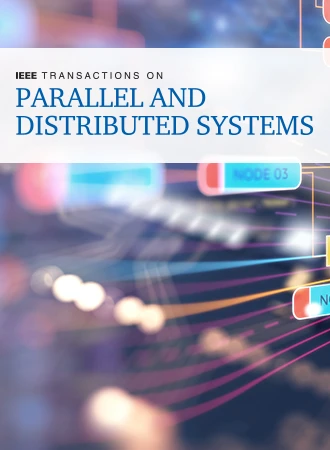低通信分布式推理变压器结构协同设计
IF 5.6
2区 计算机科学
Q1 COMPUTER SCIENCE, THEORY & METHODS
IEEE Transactions on Parallel and Distributed Systems
Pub Date : 2024-12-25
DOI:10.1109/TPDS.2024.3521582
引用次数: 0
摘要
变压器模型已经在广泛的任务中显示出显著的成功。然而,其推理所需的大量资源阻止了在资源相对有限的单个设备上部署,从而为整合其进步留下了很高的门槛。观察边缘设备上的智能家居应用和商用硬件上的云部署等场景,它有望跨多个设备分发Transformer推断。不幸的是,由于Transformer模型的紧密耦合特性,现有的模型并行性方法需要频繁的通信来解决数据依赖性,这使得它们不适合分布式推理,特别是在互连相对较弱的情况下。在本文中,我们提出了DeTransformer,一个通信高效的分布式变压器推理系统。DeTransformer的核心思想是协同设计Transformer架构,以减少分布式推理过程中的通信。DeTransformer基于一种新颖的块并行方法,该方法将原始的具有单个块的Transformer层重构为具有多个子块的解耦层。因此,它可以利用子块之间的模型并行性。其次,DeTransformer包含一种自适应执行方法,可以在多个设备上的通信能力、计算能力和内存预算之间进行权衡。它结合了两个阶段的执行计划,即静态计划和运行时计划。静态规划离线运行,在执行之前包含一个分析过程和权重放置策略。运行时规划根据实时请求从精心设计的搜索空间动态确定最佳并行计算策略。值得注意的是,这种执行方法可以根据设备的计算能力分配工作负载,从而适应异构设备。我们对Transformer模型的自回归和自编码器任务进行了实验。实验结果表明,与SOTA方法相比,DeTransformer在4个设备上的分布式推理延迟减少了2.81倍,同时有效地保持了任务精度和一致的模型大小。本文章由计算机程序翻译,如有差异,请以英文原文为准。
Co-Designing Transformer Architectures for Distributed Inference With Low Communication
Transformer models have shown significant success in a wide range of tasks. However, the massive resources required for its inference prevent deployment on a single device with relatively constrainted resources, thus leaving a high threshold of integrating their advancements. Observing scenarios such as smart home applications on edge devices and cloud deployment on commodity hardware, it is promising to distribute Transformer inference across multiple devices. Unfortunately, due to the tightly-coupled feature of Transformer model, existing model parallelism approaches necessitate frequent communication to resolve data dependencies, making them unacceptable for distributed inference, especially under relatively weak interconnection. In this paper, we propose DeTransformer, a communication-efficient distributed Transformer inference system. The key idea of DeTransformer involves the co-design of Transformer architecture to reduce the communication during distributed inference. In detail, DeTransformer is based on a novel block parallelism approach, which restructures the original Transformer layer with a single block to the decoupled layer with multiple sub-blocks. Thus, it can exploit model parallelism between sub-blocks. Next, DeTransformer contains an adaptive execution approach that strikes a trade-off among communication capability, computing power and memory budget over multiple devices. It incorporates a two-phase planning for execution, namely static planning and runtime planning. The static planning runs offline, containing a profiling procedure and a weight placement strategy before execution. The runtime planning dynamically determines the optimal parallel computing strategy from an expertly crafted search space based on real-time requests. Notably, this execution approach can adapt to heterogeneous devices by distributing workload based on devices’ computing capabilities. We conduct experiments for both auto-regressive and auto-encoder tasks of Transformer models. Experimental results show that DeTransformer can reduce distributed inference latency by up to 2.81× compared to the SOTA approach on 4 devices, while effectively maintaining task accuracy and a consistent model size.
求助全文
通过发布文献求助,成功后即可免费获取论文全文。
去求助
来源期刊

IEEE Transactions on Parallel and Distributed Systems
工程技术-工程:电子与电气
CiteScore
11.00
自引率
9.40%
发文量
281
审稿时长
5.6 months
期刊介绍:
IEEE Transactions on Parallel and Distributed Systems (TPDS) is published monthly. It publishes a range of papers, comments on previously published papers, and survey articles that deal with the parallel and distributed systems research areas of current importance to our readers. Particular areas of interest include, but are not limited to:
a) Parallel and distributed algorithms, focusing on topics such as: models of computation; numerical, combinatorial, and data-intensive parallel algorithms, scalability of algorithms and data structures for parallel and distributed systems, communication and synchronization protocols, network algorithms, scheduling, and load balancing.
b) Applications of parallel and distributed computing, including computational and data-enabled science and engineering, big data applications, parallel crowd sourcing, large-scale social network analysis, management of big data, cloud and grid computing, scientific and biomedical applications, mobile computing, and cyber-physical systems.
c) Parallel and distributed architectures, including architectures for instruction-level and thread-level parallelism; design, analysis, implementation, fault resilience and performance measurements of multiple-processor systems; multicore processors, heterogeneous many-core systems; petascale and exascale systems designs; novel big data architectures; special purpose architectures, including graphics processors, signal processors, network processors, media accelerators, and other special purpose processors and accelerators; impact of technology on architecture; network and interconnect architectures; parallel I/O and storage systems; architecture of the memory hierarchy; power-efficient and green computing architectures; dependable architectures; and performance modeling and evaluation.
d) Parallel and distributed software, including parallel and multicore programming languages and compilers, runtime systems, operating systems, Internet computing and web services, resource management including green computing, middleware for grids, clouds, and data centers, libraries, performance modeling and evaluation, parallel programming paradigms, and programming environments and tools.
 求助内容:
求助内容: 应助结果提醒方式:
应助结果提醒方式:


